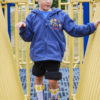Editor Message
 The weight problem
The weight problem
Many, many stories in both LER: Pediatrics and its parent publication, Lower Extremity Review, highlight the biomechanical and physiological effects of being overweight or obese.
It’s cliché, but the problem is truly a vicious cycle. Physical inactivity, often a byproduct of an existing lower extremity condition, adds to the problem of excess weight, and excess weight promotes increasingly sedentary behavior. Patients gain more weight, lose mobility and function, and their risk for myriad comorbidities grows.
Research continues to show these effects can begin at very young ages.
A recent study on foot function in more than 7000 children found obesity starts increasing foot loading in children as young as 2 years (see “Excess weight affects foot loading, peak pressure even in young kids,” page 6).
Previous research reported in LER: Pediatrics has also found evidence suggestive of conditions once considered purely adult diseases in kids who carry excess weight. Viennese researchers, for example, reported magnetic resonance imaging showed knee cartilage lesions in morbidly obese children as young as 9 years (see “Childhood obesity and OA: Can early care reduce risk?” August 2015, page 15).
Lower extremity practitioners are in a unique position to help these children and their parents by reducing pain and improving function and mobility. In-shoe orthoses, braces, physical therapy, conditioning programs, and other care all can help children lead more active lives.
Physical activity, however, can also lead to injury (see “Look out below: Injury risk on the trampoline,” page 15). But, as sources for that article note, all activity that goes beyond sitting on the couch can potentially cause injury, and, sometimes, even exercise deemed “risky” may be preferable to the dangers of inactivity.
Here again, lower extremity practitioners can help by educating parents about injury prevention—and by talking early about the immediate and long-term effects of obesity on children’s development and health.
By Emily Delzell, Senior Editor











